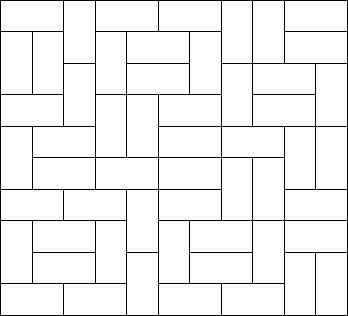标签:des style blog http io ar color os sp
给出一个n*m的棋盘,及一个小的矩形1*2,问用这个小的矩形将这个大的棋盘覆盖有多少种方法。
dp[i][j]:有多少种方法,可以使得第i行的状态为j
dp[i][j]=sum{dp[i-1][k],k可以通过合法变化变成状态j}
0:该位置空余
1:该位置被占
有的人问,每个位置不是3种状态吗?即不放矩形,横放一个矩形,竖放一个矩形
当然了,这样定义状态也是可以的,用三进制。
用三进制的话,位运算什么的都要手写比较麻烦……
还是二进制吧,那为何这样定义是可以的呢?
假设在某位置横放是以这个位置为矩形的左端,竖放是以这个位置为矩形的下端
那么,如果i行j列被占了,那么第i+1行j列是不是不能竖放?
如果i行j列没有被占了,那么第i+1行j列是不是只能竖放?
这样考虑,问题就可以由放矩形变成占据一个位置
如果还是不明白的,看看我的代码就明白了,如果还是不明白……
#include<iostream>
#include<cstring>
using namespace std;
long long dp[20][1<<11];
int n,m;
void dfs(int s,int row,int line,long long val)
{
int i,k;
k=m-1;
dp[row][line]+=val;
for(i=s;i<k;i++)
if((line>>i&1)==0)
if((line>>i+1&1)==0)
dfs(i+2,row,line|(1<<i)|(1<<i+1),val);
}
int main()
{
int i,j,k;
while(cin>>n>>m)
{
if(n==0&&m==0)
break;
memset(dp,0,sizeof(dp));
dfs(0,0,0,1);
k=1<<m;
for(i=1;i<n;i++)
for(j=0;j<k;j++)
dfs(0,i,k-1^j,dp[i-1][j]);
cout<<dp[n-1][k-1]<<endl;
}
return 0;
}
POJ - 2411
| Time Limit:3000MS | Memory Limit:65536KB | 64bit IO Format:%I64d & %I64u |
Description

Input
Output
 For each test case, output the number of different ways the given rectangle can be filled with small rectangles of size 2 times 1. Assume the given large rectangle
is oriented, i.e. count symmetrical tilings multiple times.
For each test case, output the number of different ways the given rectangle can be filled with small rectangles of size 2 times 1. Assume the given large rectangle
is oriented, i.e. count symmetrical tilings multiple times. Sample Input
1 2 1 3 1 4 2 2 2 3 2 4 2 11 4 11 0 0
Sample Output
1 0 1 2 3 5 144 51205
Source
标签:des style blog http io ar color os sp
原文地址:http://blog.csdn.net/stl112514/article/details/41874079